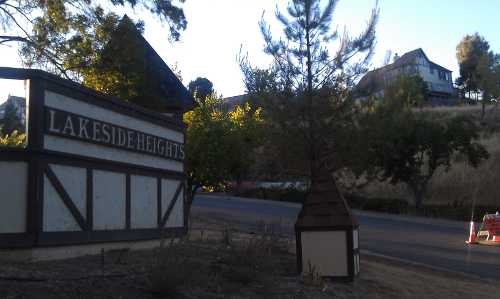
LAKE COUNTY, Calif. – Property owners in the north Lakeport subdivision where a landslide has destroyed several homes will sue the county of Lake after their tort claims that blame the public water system for the damage were rejected.
In July, 45 separate tort claims seeking damages were filed against the county of Lake by property owners in the Lakeside Heights subdivision, as Lake County News has reported.
The claims were processed by the county’s third-party administrator, the George Hills Co., which had 45 days to either accept or reject them.
Two weeks ago, the company delivered to the county copies of the rejections of each of the claims, according to County Counsel Anita Grant.
“That starts the six-month clock for the claimants to initiate litigation,” Grant said.
Attorney Michael Green of the Santa Rosa law firm Abbey, Weitzenberg, Warren & Emery – which is representing all of the subdivision's property owners – said his clients will be moving forward with a single lawsuit as opposed to numerous individual suits.
“Each property owner will be a separate plaintiff with their own individual claim, however, in this single lawsuit,” he said.
Beginning in March, the hilltop cluster of 29 mostly Tudor-style homes – the earliest of which date back to the early 1980s – saw several homes along Lancaster Road destroyed and others damaged as part of the hillside began to deteriorate and slide away, also threatening nearby Hill Road.
The claims alleged the county-maintained public water system serving the subdivision “failed in that numerous breaks occurred and/or existed in said public water system such that a substantial flow of water, over some unknown period of time, leaked into the land/hillside.”
The hillside’s destabilization, according to the language of the claims, is “a direct and proximate result” of that water system failure which, in turn, has damaged and devalued homes and property.
On July 3 claims were lodged against the county by James Andrews, Argonaut Properties LLC (two claims, one by and through its agent, Mark Tanti, a second by and through its agent, James Andrews), Carol Blair, Terry Blair, Alberta Diaz, Lois Deuchar, Robert Deuchar, Blanka Doren, Randall Fitzgerald, Jose Martinez Florez, Jonathan Gibson, Rachell Gibson, Manpreet Gill, Anton Herling (two claims), Floyd Hollenback, Kory Hudson, Garey Hurn, Fred Johnson, Vernetta Johnson, Mike Kropa, Lakeside Heights Homeowners Association (through its president, Robert Deuchar), Odell Landers III, Paul Loewen, Sheryl Loewen, Lam Mai, Daniel Malugani, Marian Malugani, Kevin Nguyen, Taryn Norton, Nanette Ruth, Paul Ruth, Roderick Schnabl Jr., Jagtar Singh, Robin Spivey, Scott Spivey, Nancy Steenburgh, Tyrone Steenburgh, Mark Tanti, Heidi Thomason and Eleanor Young.
On July 24, three more claims followed, from Enoch Duplechan, Erna A. Thomason and Ken Thomason.
Grant told Lake County News in a previous interview that it was the largest number of claims she recalled ever having been filed against the county involving the same allegations and circumstances.
Differing views of the root cause
In the months since the landslide began, county officials have continued to explore issues surrounding the subdivision.
In April, the Board of Supervisors enacted a local emergency hoping for a state emergency proclamation to aid in funding to mitigate the subdivision’s issues.
A number of leak tests were undertaken with mixed results. The first test pointed to a subdivision-owned, 2-inch irrigation line as a leak source, while several later tests showed what were characterized by the testing company as relatively small leaks in the county-maintained system.
Property owners in the subdivision have told Lake County News that they believe those leak tests undertaken in the spring in fact showed that the county water system had contributed to the problem, saturating the hillside and leading to its collapse.
Supervisor Anthony Farrington, whose district includes Lakeside Heights, said at a May meeting that the homes have a variety of foundation styles, from slabs to pier post, with the latter pointing to what he said was a historical knowledge of soil instability.
Public Works Director Scott De Leon said at that same meeting that drilled pier foundations like some of those found at Lakeside Heights are used in areas of weak soils or fill. Building records also have pointed to areas of fill within the subdivision – including the landslide area along Lancaster Road – as deep as 16 feet.
Over the summer Gov. Jerry Brown indicated he would not grant the state emergency proclamation in response to the board’s April local emergency declaration.
The supervisors, however, have kept the local emergency in place while county agencies like Special Districts continue to look for answers and solutions, with plans under way to move the utility facilities within the subdivision to more stable ground.
County officials reported at a Board of Supervisors meeting earlier this month that ground movement has, for the most part, stopped, but now the concern is forming plans to make sure the slide area is kept dry during the coming wet winter months.
De Leon is expected to present winterization options to the board at its meeting next Tuesday, Sept. 17.
Green said the property owners’ legal claims against the county arise under the California Constitution.
He said the California Constitution protects homeowners in situations where the course of behavior of a public entity results in the destruction, damage or devaluation of a homeowner’s property.
“This type of claim is called inverse condemnation,” he said, and that is what’s alleged with regard to Lakeside Heights.
Green said the case is not seeking millions of dollars for each homeowner.
Instead, he said the value of each of the homeowners’ claims will be measured by the loss in value of their property.
“In most instances it’s a total loss because even the homes that have not been completely destroyed now have no resale value,” he said.
Email Elizabeth Larson at

 How to resolve AdBlock issue?
How to resolve AdBlock issue? 



